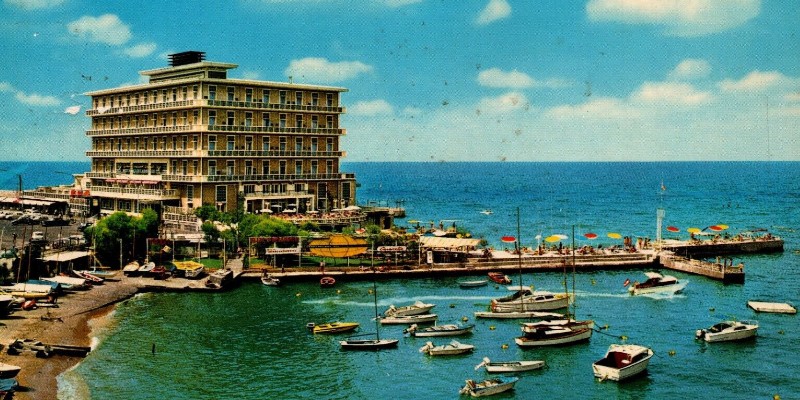Bars in grand hotels figure prominently in the canon of spy literature. One of the pleasures I get from reading the novels of Joseph Kanon, Graham Greene and other masters of the spy genre, is that the anonymous guests in the grand hotels come alive with a backstory and confidential business discussed over martinis is tantalizingly revealed. These intimate, dark, private settings facilitate the whispered conversations that set in motion the skullduggery of espionage: bribes, coups, assassinations, and the exchange of classified information. While researching my new novel, I knew I would place one critical scene in the bar of Beirut’s St. Georges Hotel.
My work in the music industry, before I became a full-time novelist, took me around the world and I was fortunate to stay in many grand hotels: the Peninsula in Hong Kong, the Okura in Tokyo, the Dorchester in London, the Plaza Athénée in Paris, among others. As I entered the hotels, I took note of the uniformed bellmen’s polite smiles, the brisk efficiency of the registration clerk, and the gilded extravagance of the lobbies. Everywhere, there was an air of sophistication, and the variety of hotel guests drew my eye. The obvious tourists mixed with well-dressed men and women doing private business over cocktails. Glamor, mystery, and curiosity. Who were these elegant people? What dark business were they conducting?
The bar in Berlin’s Hotel Adlon provided Joseph Kanon a useful setting for two novels, The Good German and The Berlin Exchange. The Adlon of 1920’s was the center of Berlin night life, attracting film stars, including Marlene Dietrich and Charlie Chaplin, and it retained some of its glamor during East Berlin’s grim Cold War years. The convivial bar was centrally located across from the Brandenburg Gate and near the Soviet embassy, which filled the bar with boisterous Russians. Kanon’s Hotel Adlon of the early 1960s is a bit dimmer, a bit less grand, but it remained a convenient spot for secret messages exchanged between strangers and dangerous liaisons. The Hotel Adlon also figures in the Berlin novels of David Downing and Philip Kerr.
Graham Greene’s Continental Hotel in The Quiet American is faithful to the role the French colonial hotel played in the Indochina War – a rendezvous spot for journalists, diplomats, and spies who convened in the ground floor bar to trade war gossip and political news, earning it the nickname Radio Catinat, for its location on Rue Catinat. The bar is where the American Pyle meets the young Phoung, Fowler’s Vietnamese girlfriend, setting up a romantic triangle that drives the novel’s plot. It’s where Fowler drinks with his press corps colleagues and contemplates his jealous dislike of Pyle.
Ian Fleming’s Casino Royale is a thinly veiled version of the Hotel Palacio Estoril in Cascais, Portugal. Fleming was briefly stationed in Portugal during WWII when he worked for MI6. He spent time in the hotel’s bar and at the baccarat tables. It was there that he met another MI6 agent, the suave, cultivated Serbian Dusko Popov, who supposedly became the inspiration for James Bond.
The St. Georges Hotel got my attention while I was researching Beirut Station. For more than half-a-century, the St. Georges Hotel’s original bar and casino provided a setting for the human dramas of espionage in the Middle East. Although the hotel-proper was closed during the time when my novel was set, the pool and outdoor restaurant were still open, and was the perfect place to set a pivotal scene.
The St. Georges Hotel was built in 1934 while Lebanon was still a French Mandate country and it quickly become an iconic symbol of the new Beirut – an elegant hotel on a coastal promontory surrounded on three sides by the Mediterranean. The country’s Swiss-like bank secrecy laws attracted wealthy depositors and Lebanon’s permissive society drew dissident intellectuals from repressive regimes in neighboring countries. Beirut was neutral safe haven in a region where Soviet and American interests competed to assert influence over the direction of nationalist movements. No city was better positioned to host the men and women who plotted the region’s future.
MI6 made Beirut its regional headquarters after the 1951 Suez fiasco and the US sent 1,700 marines to Beirut in 1955, claiming it wanted to protect Lebanese sovereignty against pro-Soviet forces. To paraphrase a Lebanese journalist, Said Aburish, if Beirut was the center of the Middle East, the St. Georges Hotel was the center of Beirut, and the bar was the center of the St. Georges.
It was at 3 P.M. on a blustery January day in 1963, when MI6 agent Kim Philby finished his customary round of afternoon martinis in the St Georges Hotel’s bar, said a few goodbyes to waiters and the bartender, who expected to see him the next day, and made his way to a Russian trawler in the port, and vanished. The most notorious double agent in this history of espionage showed up in Moscow a few weeks later.
Fortune magazine called the St. Georges one of the top hotels in the world, noting its location, its generous mixed drinks, and competent and unobtrusive service that drew a glamorous clientele of diplomats, businessmen, actors, and spies. It was a safe place from which to observe and influence the region’s unfolding conflicts. The CIA’s Miles Copeland and Kermit Roosevelt were familiar faces at the bar as were agents of Mossad, MI6, France’s DGSE, and the KGB.
By 2006, the St. Georges Hotel was shuttered and in disrepair, but its pool and outdoor restaurant attracted foreign tourists, local businessmen, visiting Arabs interested in the city’s permissive offerings. Local politics were dominated by Syrian and Iranian-backed militias. Then Israel invaded Lebanon setting the stage for Beirut Station.
I went back to Graham Greene’s The Quiet American. I marveled how Greene’s first mention of the Continental Hotel introduces his characters, establishes the tone of the book, and sets the stage for what follows. The narrator says: “I had seen him last September coming across the square towards the bar at the Continental: an unmistakably young and unused face flung at us like a dart….’Do you mind?’ he had asked with serious courtesy. ‘My name’s Pyle. I’m new here,’ and he had unfolded himself around a chair and ordered a beer.”
***


















